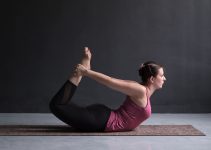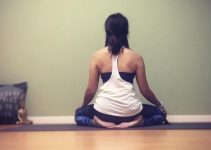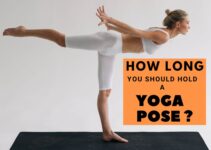
Ardha bhekasana or the half frog yoga pose prepares the body to attain the full frog pose by opening up the hip joint.
It’s also known as eka pada bhekasana. In terms of follow-up practice, Ardha bhekasana an advanced variation of bhujangasana that shares a similar back-bend foundation.
Attain the pose by first coming into the sphinx pose. Later, bend the knees and grab the foot with your hand to press the heel towards the respective buttock. The alternative hand is also engaged in supporting the lifted torso.
It is an asymmetric stretching posture that opens hips, simultaneously stimulating the shoulders, chest, and thighs. Therefore, practice Ardha bhekasana to strengthen the front and back body all at once.
Ardha Bhekasana Meaning
It is better to dive deep into the name of the pose to understand its concept. Ardha bhekasana is a composite term having the following root terms taken from Sanskrit.
- “Ardha” refers to “half”
- “Bheka” means “frog”
- “Asana” is “pose”.
Therefore, in English, it is referred to as the Half frog pose. In this posture, one half of the body with heel pressed against the hip mimics a frog, hence named as half frog pose.
It is also sometimes referred to as Eka pada bhekasana or one-legged frog pose, as the only leg is involved at a time to get into the posture.
This pose is performed in the prone position flexing a knee, stretching the leg and back. It massages the abdominal organs, strengthens the lower back, and improves the wear and tear mechanism of the knees.
Ardha Bhekasana Practice Guide
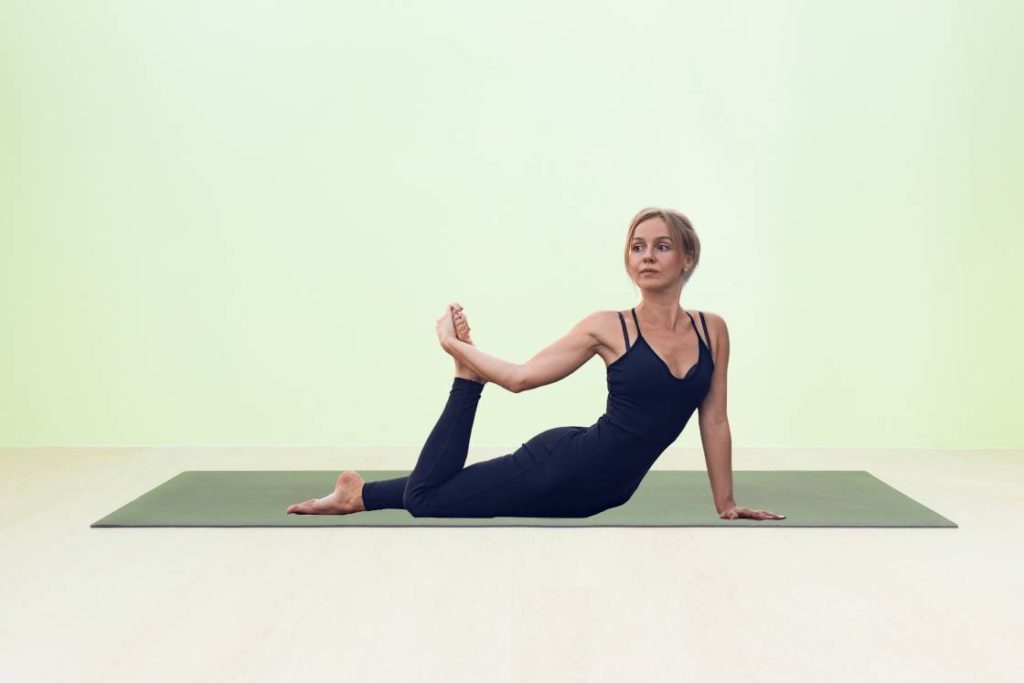
Contraindications
Make sure you are physically ready and free of these ailments before stepping into the pose.
- Do not perform it with an injury in the neck, back, shoulders, hips, or knees.
- Avoid this pose if you have arthritis in the knees or ankles.
- People with migraines should avoid this pose.
- If you have a hernia, it’s better not to try ardha bhekasana.
- People with abnormal blood pressure must refrain from this pose.
- Avoid it if you are recovering from recent surgery on the back or waist.
- Insomnia patients must also avoid this posture.
Preparatory Poses
- Hero Pose (Virasana)
- Reclined Hero Pose (Supta Virasana)
- Bridge Pose (Setu Bandha Sarvangasana)
- Cobra Pose (Bhujangasana)
- Locust Pose (Shalabhasana)
How to Do Ardha Bhekasana (Steps)
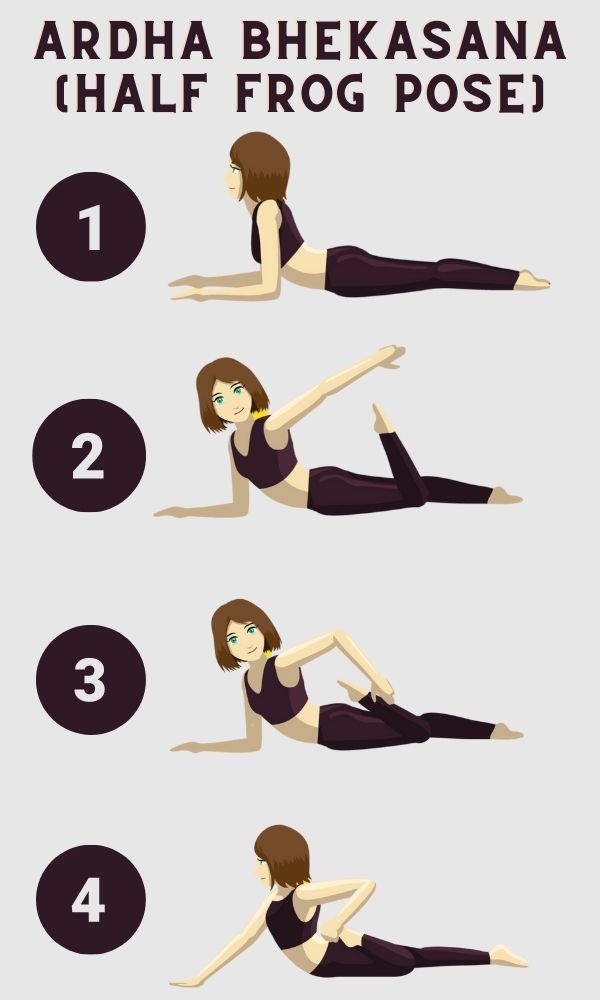
- Lie on your back with forearms on the floor and lifted head and chest.
- Flex the right knee to bring the heel towards the corresponding buttock.
- Pressing the left forearm to the floor reach back with your right hand to clasp the raised foot.
- Gently sliding the fingers towards the toes rotate the elbow up to the ceiling.
- Curling the fingers on top of the toes press the foot towards the hip.
- Inhale raising the chest and exhale pressing the foot towards the floor to deepen the pose.
- Inhale lift the left elbow pressing the left hand to the floor.
- Keep looking down and hold the pose with normal breathing.
- Maintain the pose for at least five breaths to 60 seconds.
- Exhale releasing the hand and feet and repeat it to the opposite side.

Follow-up Poses
Precautions
Keep some alignments in mind while performing the pose as mentioned below:
- Ensure that in the initial prone position the elbows are stacked under the shoulders.
- The bent knee must be aligned with the hip.
- Press the foot only to feel the stretch and not any pain in the knee.
- Hold the foot from the inside edge and then slide fingers to reach the toes.
Modifications
- Using Bolster – Bolster is the best prop for this asana especially for the beginners. Place a bolster under the lower rib while lifting the upper torso. It provides additional support to the body and eases the lift. Afterward, place the supporting arm in front of the bolster.
- Yoga strap – You can wrap a strap around the lifted foot. Then, rather than reaching the foot with a hand you can hold the strap and stretch the leg further.
Variations
The variations could be observed for the initial poses. Instead of performing it on sphinx pose, people use different poses, to begin half frog pose like crocodile pose. Some use the twisted monkey pose or other variations of the cobra pose.
- Arm variation – Depending upon the flexibility, if there is a strain lifting the supporting arm, try this. While holding ardha bhekasana, you can keep the supporting forearm parallel to the front end of the mat. This variation is safer as the elbows are pressed to the floor preventing the shoulder from dropping.
- Frog Pose – This is the advanced variation of ardha bhekasana. To transform into this posture, bend both the knees simultaneously. Reach the feet with both hands lifting the chest. Balance the body opening the hips.
Therapeutic Applications
- Ardha bhekasana is a great posture to rectify any postural defects.
- People having flat feet gets benefits from this pose as it improves the middle arch of the feet.
- It has relieving actions on menopausal cramps and menopausal symptoms.
- This posture is beneficial in curing asthma.
- Sciatica people also get relief performing this asana.
- Ardha bhekasana is an intense stretch that makes the bones stronger. Thus, it acts as a therapeutic pose for osteoporosis patients.
- This posture stretches the groins and inner thighs stimulating the reproductive organs. Therefore performing it also cures infertility.
Ardha Bhekasana Benefits
1. Enhances spinal strength
Ardha bhekasana is a back-bending posture. It massages the entire spine gently. It expands the back muscles and makes the upper and lower back stronger.
2. Stretches the chest, shoulder, and arms
Along with focusing on the posterior region, it benefits the anterior body. It opens the chest and stretches chest muscles. The shoulders and arms are actively engaged to hold the pose. It increases the elasticity of these muscles and improves their efficiency.
3. Improves digestion
The pose is performed lying on the belly. It pressurizes the abdominal organs; the stomach, intestines, kidneys, liver, etc. Hence, it facilitates better digestion.
4. Strengthens the hip flexors
Ardha bhekasana is an intense stretch that opens the hips. The pose is intense enough to stimulate the inner hips and activates the hip flexors. Thus stretches and strengthens the hip flexors.
5. Reduces belly fat
The posture exerts pressure on the abdominal muscles. This leaves a toning effect on the abdomen by shedding the extra fat layers around the belly.
6. Stimulates thyroid gland
The neck muscles are also stretched in the pose. It activates the thyroid gland and secretes the thyroid hormones. It is beneficial in regulating the body’s metabolism.
Conclusion
Ardha bhekasana is an important pose, especially for runners, cyclists, hikers, or walkers. It stretches the entire body and improves the overall muscular strength.
Therefore, if you are someone looking for ways to fortify your muscles, knees, or other joints, ardha bhekasana is worth trying.fy your muscles, knees, or other joints, ardha bhekasana is worth trying.
